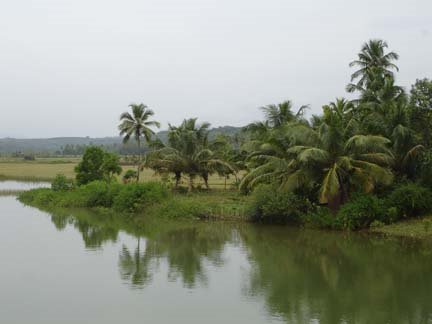Saturday, August 13, 2016
360. Origin of words: Bari and Kepulo
Saturday, January 23, 2010
225. Mura, the laterite

Languages, like those of Dravidian Group, are like large botanical farms spread over millions of hectares of land, with lateral variations in morphology.Like farms, the languages also grow and evolve in situ in the region. But the words are like seeds or seedlings.They can be brought from other regions or can be carried to other regions along with the migrants. When we decipher that so and so word may have been brought from an African or other source people jump to negate instantly comparing that the two languages (donor and receipent) are starkly different in terms of linguistic structure and composition.
Like the farms, languages are not static. They evolve over a period of time. History is a prolonged period of time.The past may have been tumultuous periods when one set of well grown languages, due to socio-cultural clashes, were eventually overpowered and modified over a period of time into another set of languages.
East African word
To the list of words derived from African sources, we may add one more word now familiar in Tulu language. In the coastal region laterite is a common occurrence.Most of the area is covered by a hard cap of reddish or brownish rock known as ‘laterite’ and we call it ‘mura’ or murakallu. Murakallu is a familiar soft rock rock that hardens upon exposure to daylight.Murum is used in civil engineering also. While levelling and paving or ashpalting, rubbles are spread and murrum is put over these stone pieces.
It is difficult to estimate the period when the laterite were cut into bricks and used for construction of houses.However, if you see the traditional large axe that is employed to cut the bricks, you may be reminded of the legends of Parasurama.
The laterite in East Africa is known as ‘murrum’ in their language. It is possible that early human migrants carried this word from East Africa to the Tulunadu.
®
Wednesday, February 21, 2007
Language and culture
Language and culture are sensitive and emotional issues. We all have grown up with certain set of ideas and it will be difficult to give up our clichés when somebody suggests anything contrary to our coveted opinions.
Anthropologists are almost unanimous that early man originated in
Dravidians as well as Aryans have settled in
It is just like the comfortable experience we enjoy in the house or the town in which we live and wherein many of our ancestors had have lived. Just because several generations of our ancestors lived in this house or town and etched unforgettable pages in the history should not mean that at some point of early period of history, one of our primal ancestors came from some other town and settled here.
If we believe that human populations migrated, it is taken for granted that the proto languages they were speaking and the cultural habits they were accustomed to also migrated with them to different parts of the world.
Blog Archive
Books for Reference
- A Comparative Study of Tulu Dialects By Dr. Padmanabha Kekunnaya. Govinda Pai Reserach Centre, UDupi. 1994
- Koti Chennaya: Janapadiya Adhyayana. By Dr. Vamana Nandavar. Hemanshu Prakashana ,Mangalore.2001.
- Male kudiyaru. Dr B. A.Viveka Rai and D.Yadupathi Gowda, Mangalore University,1996.
- Mogaveera Samskriti By Venkataraja Punimchattaya. Karnataka Sahitya Academy.1993.
- Mugeraru:Jananga Janapada Adhyayana. By Dr Abhaya Kumar Kaukradi.Kannada & Culture Directorate,Bangalore & Karnataka Tulu Academy, Mangalore,1997.
- Puttubalakeya Pad-danagalu. Ed: Dr B.A.Viveka Rai,Yadupati Gowda and Rajashri, Sri Dharmasthala Manjunatheswara Tulu Peeta. Mangalore University.2004
- Se'erige. Ed:Dr K.Chinnapa Gowda.Madipu Prakashana,Mangalagangotri,2000.
- Studies in Tuluva History and Culture.by Dr P Gururaja Bhat (1975).Milagres College,Kallinapur,Udupi.
- Taulava Sanskriti by Dr.B.A.Viveka Rai, Sahyadri Prakashana,Mysore 1977
- TuLu naaDu-nuDi By Dr.PalthaDi Ramakrishna Achar, Puttur.
- TuLu NighanTu. (Editor in Chief: Dr U.P.Upadhyaya, Govinda Pai Research Centre,Udupi. Six volumes. 1988 to 1997
- Tulu Patero-A Philology & Grammar of Tulu Language by Budhananda Shivalli.2004.Mandira Prakashana Mangalore. p.317. (The book is in Tulu Language using Kannada script)
- TuLunadina ShasanagaLa Sanskritika Adhyayana. By Shaila T. Verma (2002) Jnanodaya Prakashana,Bangalore, p.304.(Kannada)
- Tuluvala Baliyendre. Compiled by N.A.Sheenappa Hegde,Polali,Sri Devi Prakashana,Parkala,1929/1999
* Landscape images *
A Coastal estuary

Holegadde near Honavar,Uttara Kannada dist, Karnataka
Copy? Right - but kindly remember to acknowledge!
" tulu-research.blogspot." ತುಳು ರಿಸರ್ಚ್. ಬ್ಲಾಗ್ಸ್ಪಾಟ್. ಇನ್

Have a nice day !
